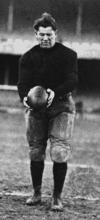- Thorpe, Jim
-
died March 28, 1953, Lomita, Calif., U.S.U.S. athlete.Of predominantly American Indian (Sauk and Fox) descent, he trained as a football halfback under Pop Warner while attending the Indian Industrial School in Carlisle, Pa. (1908–12), where he also excelled at baseball, basketball, boxing, lacrosse, swimming, and hockey. In 1912 he won the Olympic decathlon and pentathlon by wide margins, but he was deprived of his medals in 1913 after it was discovered he had played semiprofessional baseball. He later played professional baseball and football, and in 1920–21 he served as first president of what would become the National Football League. His Olympic medals were restored posthumously in 1983. Thorpe is generally regarded as the greatest American athlete of the 20th century.
 Jim Thorpe demonstrating the drop kickThe Bettmann Archive
Jim Thorpe demonstrating the drop kickThe Bettmann Archive* * *
▪ American athletebyname of James Francis Thorpeborn May 28, 1888, near Prague, Indian Territory [now in Oklahoma], U.S.died March 28, 1953, Lomita, Californiaone of the most accomplished all-around athletes in history, who in 1950 was selected by American sportswriters and broadcasters as the greatest American athlete and the greatest gridiron football player of the first half of the 20th century.Predominantly of American Indian (Sauk and Fox) descent, Thorpe attended Haskell Indian School in Lawrence, Kansas, and Carlisle (Pennsylvania) Indian Industrial School. While playing football for Carlisle under coach Pop Warner (Warner, Pop), he was chosen as halfback on Walter Camp's All-America (All-America team) teams in 1911 and 1912. He was a marvel of speed, power, kicking, and all-around ability. Also in 1912 Thorpe won the decathlon and the pentathlon by wide margins at the Olympic Games in Stockholm, but in 1913 an investigation by the Amateur Athletic Union showed that he had played semiprofessional baseball in 1909 and 1910, which should have disqualified him from Olympic competition. He was subsequently deprived of his gold medals.From 1913 through 1919, Thorpe was an outfielder for the New York, Cincinnati (Ohio), and Boston baseball teams in the National League. He was more successful as one of the early stars of American professional football from 1919 through 1926. He spent two seasons (1922–23) with the Oorang Indians, whose owner attracted crowds by having Thorpe and his teammates dress up and perform “Indian” tricks before games and at halftime. In 1920–21 he served as the first president of the American Professional Football Association (later the National Football League [NFL]). He also excelled in such diverse sports as basketball, boxing, lacrosse, swimming, and hockey. In his later years, even as he was celebrated in magazine and newspaper articles as one of the greatest athletes of all time, alcoholism and inability to adjust to employment outside sports reduced Thorpe to near poverty. The 1951 film biography of his life, titled Jim Thorpe—All American and starring Burt Lancaster, transformed his story into uplifting melodrama, with the fallen hero rescued by his old coach Pop Warner.In 1954, after his death, the communities of Mauch Chunk and East Mauch Chunk, Pennsylvania, merged to form the borough of Jim Thorpe. From 1955 the Jim Thorpe Trophy was awarded annually to the most valuable player in the NFL. In 1973 the Amateur Athletic Union restored his amateur status, but the International Olympic Committee did not recognize his amateur status until 1982. Thorpe was subsequently restored as a “cowinner” of the decathlon and pentathlon of the 1912 Olympic Games (along with the second-place finishers in those events). His Olympic gold medals were restored to his family in 1983.* * *
Universalium. 2010.
